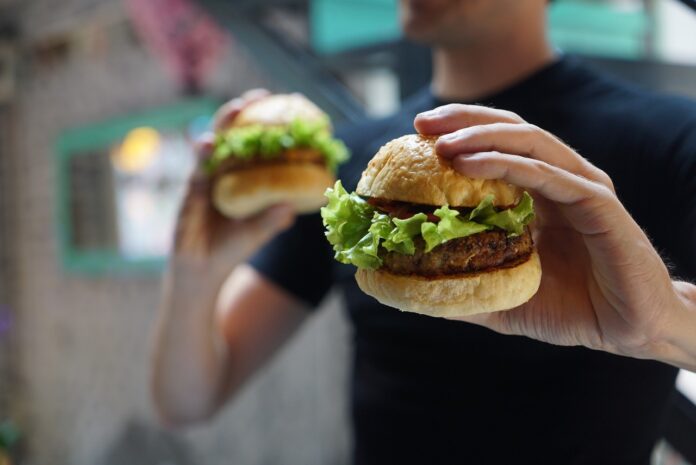The absence of juiciness in plant-based meat analogs (PBMAs) remains an unsolved difficulty. Saturated fats greatly enhance the juiciness of PBMAs; however, due to concerns regarding the potential adverse health effects of saturated fats, there is a growing demand for veggie unsaturated oils to substitute them. Even if many food additives are used to stop unsaturated oil leaks, this approach can’t comply with the new clean-label regulations.
A new study- published in PLOS One- aimed to develop better consumer-acceptable methods using protein-glutaminase (PG) to improve the juiciness of PBMA patties to meet clean-label trends.
For this study, scientists obtained soy protein composed of TVP. They experimented on soy protein isolate (SPI) and soy-based textured vegetable protein (TVP). They used an enzyme called PG at different concentrations (0–20 U/g-protein) and treated the proteins at 50°C for 180 minutes. They boiled the solution at 100°C for 5 minutes to stop the reaction.
They wanted to know how much deamidation occurred. Deamidation is when an amino acid in a protein (glutamine or asparagine) gains an ammonia molecule. They calculated the degree of deamidation (DD) by comparing the amount of ammonia released during the PG reaction to the total ammonia content in the original protein molecules.
To measure the total ammonia content, they used 3 N sulfuric acid to deamidate all glutamine or asparagine residues in the proteins and measured the released ammonia. The ammonia amounts released from protein molecules treated by PG or sulfuric acid were calculated using a commercial kit from FUJIFILM, Wako Pure Chemical Corporation, following a method described in a previous study.
Degree of Hydrolysis Calculation:
They figured out how much protein was broken down into smaller parts. They did this by comparing the amount of protein dissolved in a solution after using a trichloroacetic acid.
Protein and Peptide Measurement:
They used the Kjeldahl method to determine how much protein and smaller parts (peptides) were in the solution.
Later, scientists determined how well the proteins could hold onto liquids like water or oil. They took the dried proteins, mixed them with water or oil, shook them up briefly, and let them sit for 30 minutes at room temperature. After that, they spun the mixture in a machine to separate the solid parts from the liquid. By measuring the weight of what was left (solid and liquid), they calculated how much water or oil the proteins could hold onto for each gram of protein.
Scientists then evaluated emulsifying properties by mixing Canola oil into a 1% protein solution at a final concentration of 25%. The resultant emulsion was collected between minutes zero and ten after homogenizing the protein and lipid mixture for two minutes at 10,000 rpm. Then, a 0.1% sodium dodecyl sulfate solution was mixed with the homogenized emulsion. At 500 nm, the diluted solution’s turbidity was measured.
They made PBMA patties using TVPs (textured vegetable proteins) and a substance called methylcellulose to hold everything together. They added water, canola oil, pea protein isolates, and potato starch. Here’s how they did it:
They took dried TVP (10 grams) and soaked it in water (15 mL) for 30 minutes to make it wet. They used an enzyme called PG at different amounts (0–20 U/g-TVP) and mixed it with the wet TVP, letting it sit at 50°C for 180 minutes. They added 2.0% methylcellulose to the hydrated TVP. Then, they added water (5–25 grams), canola oil (5–18 grams), and 1.0% potato starch.
They used a blender to mix everything for 60 seconds. They shaped the mixture into patty dough (60 × 40 × 25 mm) and let it sit at 60°C for 2 hours. After that, they grilled the dough at 150°C for 10 minutes and let it cool to 20–25°C before checking it. Interestingly, they found that they couldn’t detect any PG activity in the PBMA patties after grilling.
PG treatment on TVP not only made it juicier but also helped get rid of some strange flavors. They could reduce these off-flavors by 58–85% by washing them. The PG-treated patties had more of something called FAN, a sign that the protein is easier to digest. The amounts in the stomach and intestines were 1.5- and 1.7-fold more significant than in regular patties. Because PG is inactive after the grilling process, it is not an additive by regulation.
Scientists noted, “Enhancing the juiciness of PBMA patties using PG might be a new strategy for meeting new clean-label requirements. This strategy could help food manufacturers develop clean-label PBMAs that are more attractive to consumers.”
Journal Reference:
- Kiyota Sakai, Masamichi Okada, Shotaro Yamaguchi. Protein-glutaminase improves water-/oil-holding capacity and beany off-flavor profiles of plant-based meat analogs. PLOS One. DOI: 10.1371/journal.pone.0294637
